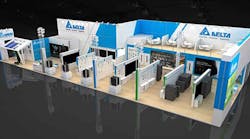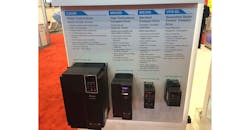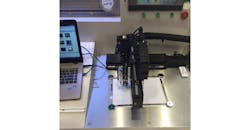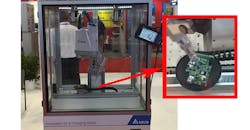A key takeaway at this week’s Industrial Manufacturing Trade Show in Chicago is that if you’re not trying to smarten up your factory floor, your company may very well fall behind in this fourth or fifth (hard to keep track nowadays) industrial revolution.
Delta Products Corp. wants you to come along for ride with its “Delta Passport,” a way to electronically reserve access to the company’s newest products and enabling technologies, being shown at Booth E-4338, that consolidate the work environment and take advantage of lightning quick EtherCAT (Ethernet for Control Automation Technology) connectivity.
These include: the new MH300/MS300 series compact AC variable frequency drives running four of the most popular spindle motors on the market; an Advanced Machine Automation Demo where visitors can execute G-Code for simple shape cutting through a simple HMI interface; and a Robotics Cell that shows off 4-axis control with integrated servo drives on a 400mm SCARA arm in a simulated conveyor tracked dispensing application.
Together they represent a snapshot of where most manufacturers are headed, if not already on the journey.
“Every company is evolving to a higher level of implementation to create this smart manufacturing environment,” says Bill Faber, director of industrial automation product marketing and business development at Delta. “Some are further along than others which is why we recognize it as a progressive journey.”
Stopping by these three cells, Faber says, will hasten that journey to a more optimized and efficient operation.
Here’s a quick look at each:
MH300/MS300 Series Compact Drives
Everyone in the workplace is being asked to do more with less, from hipster technology editors gathering intel and multimedia at gigantic tradeshows with their personal smartphone, to plant managers whose equipment budgets are dropping faster than an attention-seeking NFL player during the National Anthem.
These high-performance micro VFDs (AC Motor Drives) should provide a little relief by controlling spindle motors up to 2,000 hz and 60,000 rpm suitable even for standalone control, because the mini SS2 PLC is built right in.
Because of the built-in PLC, one drive can control its own motor sequence and sequence several other connected drives installed in a machine application.
Visitors are able to witness blindingly fast E-stops, where the spindle will go from top speed to full stop in around three seconds because of the MH300/MS300’s DC injection braking technology.
“Many competitor VFD’s could take up to 7-8 seconds to decelerate a spindle motor using traditional regeneration methods,” Faber says. “though that would lead to larger footprint, more components and higher cost.”
Overall, these VFDs, (the MH300 being EtherCAT-friendly) are the smallest drives available in the 400-v market, up to 40% smaller than other competitive offerings.
These reduce costs on multiple fronts, including integration, wiring, panel space, and IO modules.
Advanced Machine Automation Demo
This shape cutting/engraving solution enables the user to test drive Delta’s IEC61131-3 compliant software, allowing them to experience the integrated motion, logic, and device configurations.
“With the laptop at the booth, you’ll be able to interact with ISPSoft 3.0 software, adjust e-cam, motion control, and logic from one interface,” says Remy Echavarria, Delta’s PLC & HMI product manager.
“You can also interact with the DOP-B Pro Series HMI, which we’re in the process of launching,” Echavarria says. “Basically, you can upload, edit and download G-code directly from the HMI. You no longer need to use your PC to make small changes to the G code programs stored on a PLC.”
Robotic Cell
By controlling a 400mm SCARA arm, Delta intends to showcase its 4-axis control with integrated servo drives while also controlling a networked external actuator.
Delta describes it as follows:
The robot “dispensing” head dynamically tracks the LU series actuator by dispensing a constant vector path pattern while in-motion. The move profiles can be configured and taught through a Hand-held pendent complete with e-stop and 3-position safety switches. This complete cell is remotely monitored at the Industrial Ethernet display panel via a 3G cloud-connected router.
Faber hopes that after viewing these cells, IMTS 2016 attendees will be able to get a better handle on all the latest communications technology through Ethernet that you can do analytics on and how they tie together to create the smart manufacturing initiative.
And if you’re one of those types that sees automated machinery communication as a new way to force you out of the plant, Faber says Delta Products develops these products for its own manufacturing processes, and the results have been largely positive.
“Smart manufacturing really helps create efficiencies,” Faber says. “The fact is, some employees don’t necessarily like doing the tedious work. This equipment gives them an opportunity to elevate their skill set to another level, and to rise to more service-oriented positions. And as a company grows, more opportunities will be developed.”














